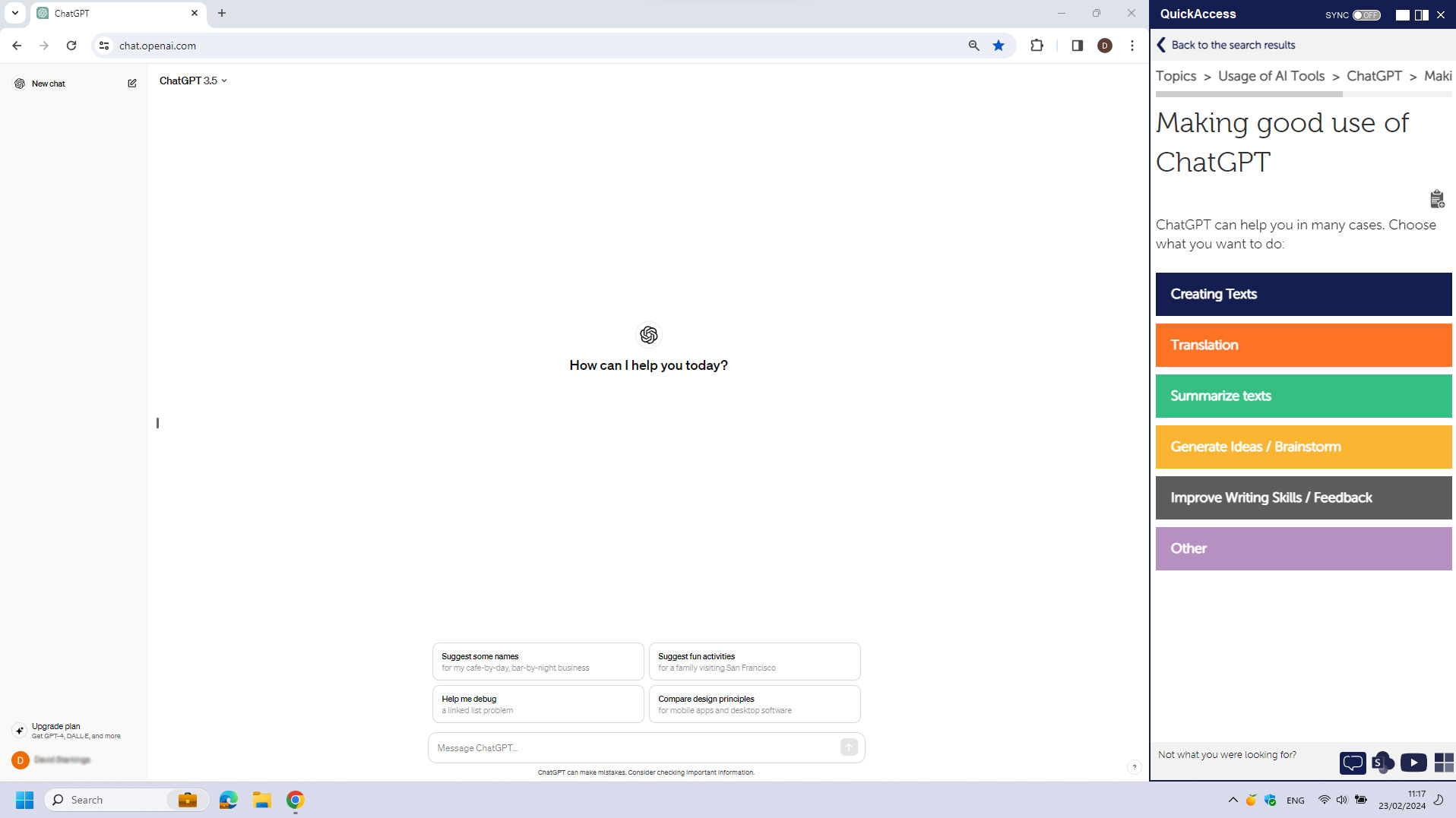DAP as an Efficiency Booster for Generative AI

It is well known that chatting is part of the trade, and Sam Altman is a true master of the discipline. According to a LinkedIn post by Handelsblatt (German business magazine), the CEO of OpenAI said at the World Economic Summit in Davos that ChatGPT could increase a company's productivity by a factor of two to five. What Altman did not mention are the many hurdles, large and small, that need to be overcome before the organization can even come close to this dimension of growth thanks to Generative AI (GenAI).
These include questions about the appropriate business case, how to prepare and protect data, and how to integrate GenAI applications into the process landscape. But that is just the beginning. Equally important is the comprehensive support of employees in the use of the new tools. Traditional training courses are limited in their ability to do this. For one thing, the technology develops and changes faster than any curriculum, and for another, the quality of the AI output depends on a large number of variables, the potential of which largely falls by the wayside if the tool is used without support.

tts performance suite's unique side-by-side approach places a help window next to the AI application
To avoid the risk of a creeping erosion of the quality of results and information, this support should also be provided at the workplace, e.g. through a Digital Adoption Platform (DAP). As part of the unique side-by-side approach of the tts performance suite, for example, a help window is placed next to the AI application like a sidebar. This makes help available to users without having to leave the AI tool. This ensures that employees can always use the GenAI program safely, confidently, and productively in accordance with AI policies. The following five use cases illustrate what DAP support can look like in detail:
Use case 1: Writing and optimizing high-quality texts
A mid-sized company decides to deploy an AI assistant (ChatGPT, Google Gemini, Microsoft Copilot, or similar) to increase the productivity of its human resources, product management, marketing, sales, and support staff. After initial training, users should
- Optimize their workflow by being reminded at the right moment that AI can help with the task at hand
- Generate high-quality text without teething problems
- Learn how to combine GenAI tools to fine-tune AI output
Step-by-step implementation with a DAP for GenAI
- Users open Microsoft Word or another word processor.
- A push message appears asking: "Would you like to write better texts with the help of AI?
- Click "Yes" to open the DAP help window next to the word processor.
- Depending on the work context and the user's role, the Digital Adoption Platform will show them which AI tools have been approved by the IT security department for the task at hand. If necessary, the platform will also display the company's current AI policy.
- ChatGPT is one of the shared tools. Clicking on it opens the AI chatbot. Depending on the application and tailored to the user's role, the DAP now suggests a selection of different text genres and provides sample prompts with placeholders for efficient text generation.
- In order to optimize the first text draft using the AI application, employees can find further tips in the DAP. The software helps with efficient prompting with appropriate examples, e.g. on tonality, text structuring, output format or the productive use of different prompting frameworks.
- If the output meets the requirements, the users confirm a corresponding query in the DAP. They are then informed that they can further optimize the language of the draft using DeepL Write.
Use case 2: Summarize emails without publishing confidential data
Email is one of the leading causes of stress, distraction and lost productivity. Too many and too long emails cost time and nerves. To change this, the management relies on the use of ChatGPT. The chatbot is designed to
- Summarize emails
- relieve employees and free up time for value-adding activities
- Be used in a way that keeps confidential information secure
Step-by-step implementation with a DAP for GenAI
- In Microsoft Outlook, click on the received email.
- Based on the prefix in the subject line, the DAP recognizes that it is a pingpong email. A push notification opens with the question "Would you like to summarize your email history with AI support?
- If you click "Yes", the DAP help window will open next to the Outlook window with a note that it is not allowed to use the public web version of ChatGPT for the summarization. Team or Enterprise ChatGPT should be used instead.
- After clicking on one of the secure workspaces, the DAP explains what to consider when prompted to summarize emails (role, format, tonality). The DAP also shows sample prompts that are appropriate for the task.
Use case 3: Writing good emails and overcoming language barriers
The company, which has offices in Europe and Asia, wants to facilitate communication between its employees, customers, and partner companies and promote international collaboration. To do this, they want employees to use the AI assistant to
- Write concise, easy-to-understand emails with a tone tailored to each recipient
- Translate emails into any of the company's languages, helping to overcome language barriers.
Step-by-step implementation with a DAP for GenAI
- Users click "New Email" in Outlook.
- A push notification appears on the screen with the question: "Would you like to write better emails with AI support - without a language barrier?
- Click on the message to open the DAP Help window. It displays an overview of all AI tools approved by the Information Security Officer. The company's current AI policy can also be found here.
- The DAP recognizes the work context and suggests appropriate prompts for composing an email. Based on this, ChatGPT writes a first draft in the user's native language.
- The next step is to optimize the draft with the help of the AI assistant. The required sample prompts are also provided by the DAP.
- In the final step, the user translates the text into the desired language. The DAP also provides the necessary prompts.
Use case 4: Process support for text-to-speech
One company is using a combination of ChatGPT and an AI-based text-to-speech tool to largely automate the process of creating instructions. In this case, users are guided through the process by the AI assistant.
- Receive process support from draft to finished audio speech
- Get the help you need to optimize the tonality and impact of the voice output
Step-by-step implementation using a DAP for GenAI
- Open the DAP and search for "Write instruction" or "Corporate wording".
- The Digital Adoption Platform help window will provide a step-by-step process for writing a speech according to the corporate wording. The DAP also displays an overview of the AI tools released in the company, a link to the current AI policy, and a note that Team or Enterprise ChatGPT must be used if the speech contains confidential information.
- As described in Use Case 1, users can find all the tips and sample prompts they need to create and then optimize the speech draft in the DAP Help window.
- In the next step, employees are prompted to copy the text into one of the approved AI text-to-speech tools.
- The DAP also provides comprehensive support in the text-to-speech tool to achieve an ideal result, including voice selection, localization, speaking style and speaking speed.
Use Case 5: Generating images with Dall-E, Midjourney or Adobe Firefly
To reduce costs and optimize the information content of its presentations, a company wants to eliminate stock photos and produce its own images. To ensure that employees quickly achieve perfect results with GenAI, they should
- Be guided step-by-step through the image creation process
- Learn all the variables for output optimization and fine-tuning
Step-by-step implementation with a DAP for GenAI
- To place an image on the title slide of a new PowerPoint presentation, open the "Insert" dialog.
- A push notification will automatically appear with the question: "Would you like to use AI to create better images for your presentations?
- Click "Yes" to open the DAP Help window next to PowerPoint. Here you will find a step-by-step process that will lead you to the perfect prompt. It also provides an overview of all AI tools approved by the company for this task, as well as the company's current AI policy.
- Sample prompts are also provided for visuals in the corporate design that can be used to achieve compelling results. Alternatively, users can follow the process to learn more about the topic.
- In this case, they first receive an introduction to prompt engineering based on various questions and use cases.
- The photographic elements are explained in the next process step. Depending on sensor size, lens focal length, depth of field, bokeh, lighting and perspective, images can be created that are indistinguishable from real photos.
- Finally, the user is given an overview of the parameters for fine-tuning the images, such as adjusting the aspect ratio, quality and stylization. Sample prompts are provided at each stage of the process, allowing users to test the effects of various manipulations.
Using GenAI productively faster with a digital adoption platform
How quickly and to what extent a company can increase its productivity through GenAI depends primarily on the operating security of the users. In any case, the use cases described prove that a digital adoption platform such as the tts performance suite provides significant assistance in this regard.
Seamlessly integrated into the existing process landscape, it proactively draws employees' attention to the benefits of generative artificial intelligence via push notifications. Depending on their role and the respective context, it provides users with tailored information on the ideal use and best possible combination of AI tools to achieve the goal of increasing productivity. It also promotes the responsible use of AI technologies by providing information on guidelines and, if necessary, recommending secure alternatives that ensure the protection of confidential data.




